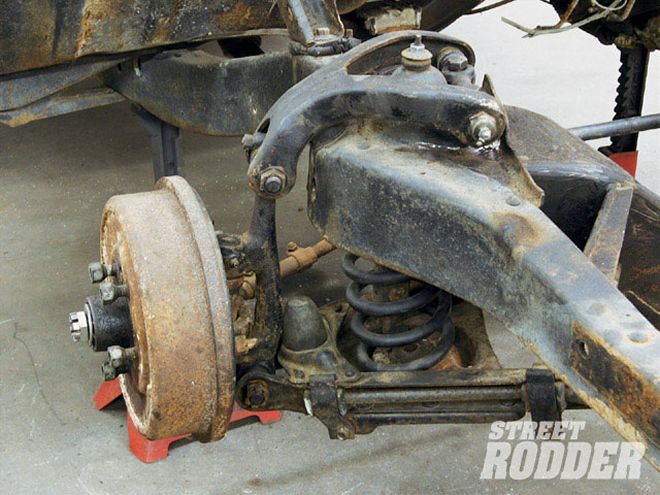
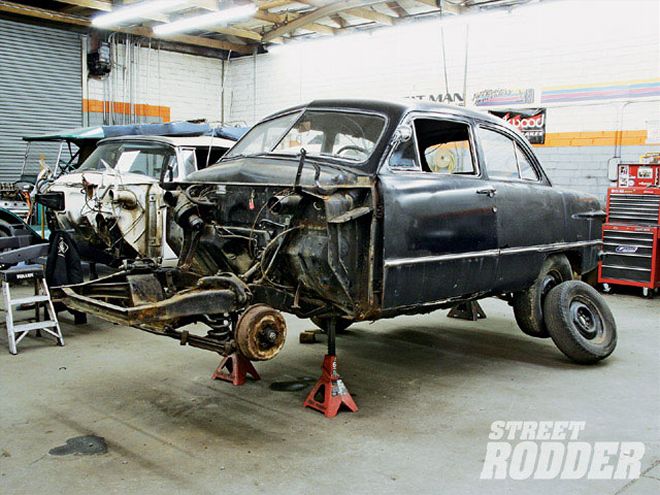 Here's what Brent VanDervort at Fatman Fabrications started with. It's a '51 Tudor owned by Jay Whelan's Rod Shop in Mathews, NC, and it has already had the nose knocked off so we can see what needs to be done. (This conversion can be done with the fenders and nose section on the car, but it becomes so much easier when they're off).
Here's what Brent VanDervort at Fatman Fabrications started with. It's a '51 Tudor owned by Jay Whelan's Rod Shop in Mathews, NC, and it has already had the nose knocked off so we can see what needs to be done. (This conversion can be done with the fenders and nose section on the car, but it becomes so much easier when they're off).
With the popularity of the '49-51 Fords in the hot rod world, STREET RODDER was pleased to find that Fatman Fabrications, headed up by Brent VanDervort in Charlotte, North Carolina, has been on top of what it takes to make them steer, stop, and ride comfortably, and has been doing so for the last 20 or so years.
Not just a manufacturer of independent front suspensions for all sorts of cars (including the '49-51 Ford), but an owner of several makes and models from that era, Brent's expertise goes beyond the builder level and encompasses his unbridled enthusiasm for the cars, too.
When we last visited his shop, he was about to start updating the steering, braking, and suspension on a friend's car, so we followed along as he addressed each component in the build-up. Options are what Brent talked about, beginning with some of the things the home builder can do to upgrade certain aspects of his car's handling without going "whole hog." Secondly, he wanted to show what has to be done to convert your power source from that tired old Flathead to a contemporary small-block-something.
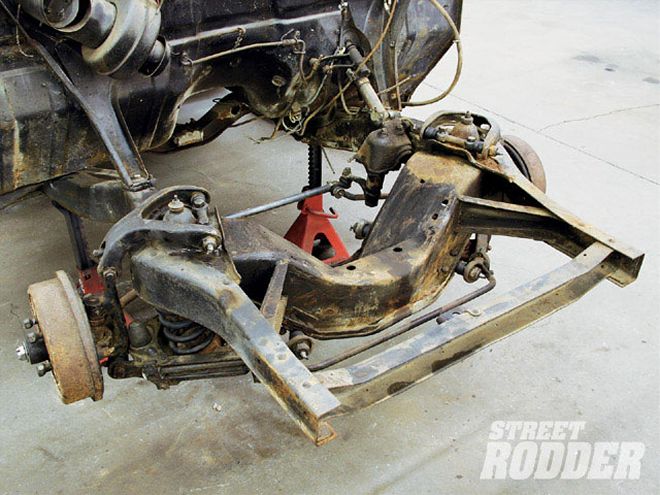 The stock IFS from Ford was a decent product when it first came out, but there were some inherent design flaws in the suspension that were corrected by Ford the following year.
The stock IFS from Ford was a decent product when it first came out, but there were some inherent design flaws in the suspension that were corrected by Ford the following year.
For those who want a little more, Fatman offers a complete IFS stub that is fairly easy to install, providing that you aren't the type who likes to go through a case of Miller while you've got a torch in your hand! Other items in an upgrade, such as choice of master cylinder location and rear suspension options, can also be addressed. As it turns out, there is enough work available on one of these cars that you can make a day of it or a week-it's up to you.
For this initial article (a total of three are planned), we'll be looking at the steering and motor mount options for the '51 Tudor. In the next article, we'll watch Fatman install one of the company's hub-to-hub conversions along with a set of disc brakes from ECI. From there, a third story will showcase what it takes to add a complete Fatman stub to a '51 Ford chassis and, hopefully, pass along some useful information in the process.
When it came to the differences between the car's stock IFS (it was the first year for IFS in a Ford) and one of Fatman's systems, Brent told us "The original chassis can be upgraded with very good results. If you have a car whose stock IFS has already been rebuilt, and want to use an engine that fits, using the original is a good option. Limited ground clearance at the front crossmember is only a problem with if you plan a four- or five-inch drop and tires with a diameter of 25 inches or less."
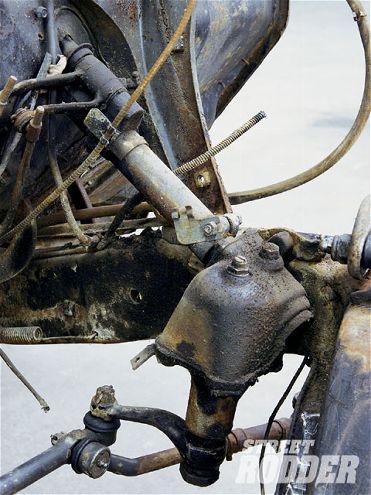 The stock steering is a reverse-rotation unit, and needs to be removed, too.
The stock steering is a reverse-rotation unit, and needs to be removed, too.
He went on to say, "The choice of engine is actually a very important factor in which way you go, too. The Flathead really only fits well with the original IFS and rear steer tie rods. My advice is to disassemble one side at a time and use it as a reference to see how the other side goes. Chevy small-blocks and early Hemis have rear sump oil pans that get into trouble with the original steering linkage, although a '65-67 Nova dual sump oil pan and associated parts will just fit. Small-block Ford V-8 engines work equally well with either the original or modern IFS, and you would need to use a dual sump oil pan in either case. Big-blocks of any type will tend to make the car pretty nose heavy to the detriment of good handling, and often require firewall surgery to fit.
"These cars use a front sway bar as original equipment, but still suffer from quite a bit of body roll. Increasing the front sway bar seems to add too much front roll stiffness, to the detriment of chassis balance and ride quality. Adding a rear bar controls the body lean and produces very neutral handling.
"Ball joints were first used by Ford in '52 on the Lincoln, but were not yet well enough developed to be used on the spindles, so in '51 they used a two-part spindle, unlike today's ball joint types.
 No ball joints here-everything worked on a kingpin system.
No ball joints here-everything worked on a kingpin system.
"The primary mechanical problem with this type of suspension is the steering system. The steering box itself is unusual in that it turns in the reverse direction of almost all others, so upgrade swap options are limited. The original steering box has that odd 45-degree intersection of the sector and worm shaft. After sampling the steering play on very low mileage cars, it appears that they were pretty loose even when new. It seems that the 45-degree angle has an inherently loose gear mesh condition that neither careful adjustment (using a manual, not just guessing at the procedure) nor a rebuild seems to help much. Rebuild parts for the boxes are rare and expensive anyway. The '51 boxes were unique and improved somewhat, but still leave much to be desired.
It happens that the '67-74 Volvo 140 Series manual steering box works very well. It turns the proper direction, is a very pretty aluminum casting with all needle bearing construction, and the '49-51 Ford pitman arm fits on it with minimal work. This box works very well with Flatheads by using tubular headers for clearance, as well as Chevy and Ford small-blocks with cast iron manifolds or block hugger headers.
Idler arm stability is a major factor in holding proper toe-in adjustment, and these old designs use a simple pressed rubber bushing which has a typical lifespan of about 10,000 miles. Further, the Ford designers seem to have misunderstood the proper position of the inner tie rod pivot location to avoid bumpsteer (a change of toe-in with suspension travel)." Brent feels safe in making that statement because Ford altered the design and position for the '52-53 years, thus solving the problem.
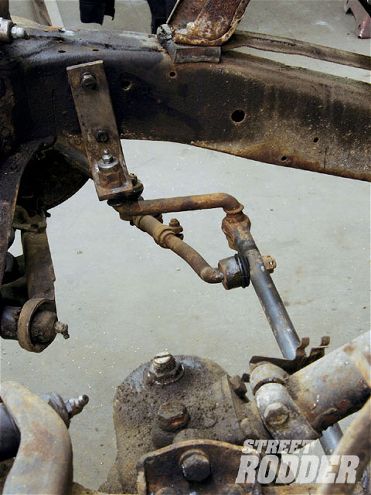 One of the flaws in the stock system is the bushings in the idler arm. They tend to wear out quickly (and something that should be checked when you're out shopping for one of these cars).
One of the flaws in the stock system is the bushings in the idler arm. They tend to wear out quickly (and something that should be checked when you're out shopping for one of these cars).
"Fatman offers a more modern idler arm that is attached to an adapter bracket that allows it to bolt to the stock holes in the frame. Needle bearings at the idler arm pivot provide a huge improvement in stability, service life, and easier steering. The tie rod set also features the relocated inner tie rod positions mentioned earlier. Where the original parts are getting harder to find, Fatman's tie rod set features all replaceable parts, and ones that are pretty easy to find for future servicing."
Fatman wrapped it up by saying they "also have a power rack and pinion kit for the stock '49-51 Ford suspension that works well with either the Ford small block (with a dual sump oil pan) or the small block Chevy (with the '65-67 Nova dual sump pan). In fact, it's hard to tell the Ford and Chevy dual sump pans apart! The Flathead will not clear the power rack at all."
So here is phase one: picking the right motor (and mounts) and addressing the steering.